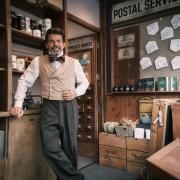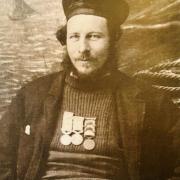These five inspiring individuals offer a fresh perspective on our county’s beautiful coastline

Racing around the coast with Anni Ridsdill Smith
The sport of paddleboarding has an enthusiastic and rapidly growing following among those wishing to explore the county’s rivers and estuaries.
Anni Ridsdill Smith runs Frangipani SUP, is a BSUPA Director, Trainer and Advanced SUP Coach for racing. She’s passionate about paddleboarding and its many benefits: ‘When I slow down, I see the natural habitat which is second to none. I paddle past protected saltmarshes and enjoy sprint training off soft sandy beaches - the county has so much to offer,’ she enthuses. While she has explored much of the coast on her paddleboard, there’s one location that particularly stands out for her: ‘Maldon is a beautiful little maritime town on the Blackwater Estuary, and I live stone’s throw from the water’s edge. My favourite route to paddle is around the back of Northey Island. We also have Osea Island and Mersea Island in the estuary, which are both very beautiful.
‘I love taking in the vistas of the skies – they’re so big and forever changing. They make me think of the world beyond these shores and about the people who have gone before, who have all looked up in awe at these breathtaking vistas over the centuries. And heading home I love to say ‘hello’ to Byrhtnoth, whose statue stands guard at the end of Maldon prom!’
While many paddleboarders are content with a slower pace on the water, Anni is a SUP racer first and foremost, training hard for events in the UK and overseas, which culminate in the World Championships each November. ‘I am usually paddling flat out to the sounds of my lungs and my heartbeat!’ she laughs. ‘Sprint is my favourite discipline and I sprinted for Team England in the European Championships in Denmark in 2022. When training sessions are done, I calm down and drift home, taking it all in.’

Those keen to learn how to paddleboard can contact the SUP schools, clubs and centres in their local area, who will be able to provide information for safe and successful paddling, including what licences or access fees might be needed. ‘Coastal tidal paddling is enjoyable and exciting but not without its dangers, so do take lessons with experts before venturing out,’ adds Anni.
Although Anni has enjoyed paddleboarding all over the world, she cites a trip in our county as one of her most memorable: ‘A touring trip that particularly stands out for me was after Covid when my husband Mike and I paddled from Bradwell to Maylandsea, as part of a virtual SUP distance event run out of Hawaii, with our great canoeist friend Clive guiding us. I love a photo that I took of them both on a rest break, I can smell the salt and feel the wind on my face when I look at it.’

In search of fossils with Peter Dimmick
Is there anything more exciting than heading to the beach for an impromptu fossil hunt, in the hope of happening across anything from a mammoth bone to a megalodon tooth? While the Jurassic Coast of Dorset and Devon is world-famous for Mary Anning’s astounding dinosaur discoveries, our own coastline also has its fair share of treasures, not least in Aveley where two different species of mammoth were discovered in the 1960s.
Peter Dimmick is a fossil enthusiast and volunteer for Essex Wildlife Trust, and is only too happy to reveal the county’s finest fossil hunting sites: ‘Wrabness, Harwich, Walton-on-the-Naze, East Mersea, Maylandsea, Steeple Bay and Burnham on Crouch are all well worth exploring,’ he asserts. ‘All these sites have fossils dating from 55 to 52 million years ago, which come out of the London Clay. At this time, Essex was covered by 200 metres of sea with the nearest land being in the Midlands. The climate then was sub-tropical, and vegetation would have been mainly palm trees, mangroves and magnolias. Most fossils are, therefore, mainly marine but do also include animals and vegetation carried out to sea by river estuaries.’

Those new to fossil hunting may be surprised to learn about the wide range to be found in the county: ‘You can find shark and ray teeth and vertebrae, fossilised wood, bird bones, lobster, crab, shells, turtles, snakes and a few mammals at most of the locations listed,’ explains Peter. ‘Walton also has the benefit of a layer of earth called the Red Crag which is 32 million years old and is stuffed full of marine shells. This only exists in Essex and a few locations in Suffolk. I have about 30 different species of marine fossil shell in my collection from Walton. An internationally rare shell which is found at Walton is Neptunea angulata or the left-handed whelk which is special because it spirals the opposite way to all other shells.’
And if you thought fossil hunting was tricky then think again: ‘Nearly everyone coming to Walton will be able to find sand shark teeth, fossilised wood and Red Crag shells all year round,’ enthuses Peter. ‘Much rarer are mackerel shark teeth, but the fossil everyone wants to find is a Megalodon tooth. Only about six of these are found every year. Because of the constant erosion of the cliffs newly exposed fossils appear all the time but you can never tell what may turn up.’
Essex Wildlife Trust offers guided walks and fossil hunts so you can be joined by an expert to help you discover a hidden treasure. Furthermore, if you find a fossil, you can visit The Naze Nature Discovery Centre where someone will help you to identify it.

Live life through a lens with Anthony Pickering
Sailing extensively from the age of 14, Anthony Pickering began his career in the Royal Commission on Historical Monuments as an assistant photographer. ‘I loved the job but left to sail to the Caribbean,’ he reveals. ‘On my return, I worked in an advertising art studio and at a picture library, as well as doing a welding course. Later I worked in steel boatbuilding and the marine trade. On semi-retirement I bought a RIB (rigid inflatable boat) to further pursue maritime photography.’
Anthony specialises in capturing the traditional craft of the east coast of England, including smacks, barges, gaff rigged craft, classic boats, small traditional boats and, more recently, traditional rowing gigs and five person racing boats. ‘I have sailed on a number of these vessels and, to me, they’re far more attractive and varied than more modern boats,’ he asserts.
Preparing for a day’s photography on the water takes a great deal of planning: ‘I wear full waterproofs whatever the weather as it can get very wet on a RIB,’ Anthony laughs. ‘I take my full-frame camera that’s already somewhat weatherproof in a Think Tank Hydrophobia rain cover. Sea water is corrosive to cameras, whatever the waterproofing claims of camera manufacturers. I use a deep lens hood and always point the camera down when not photographing to keep the spray off. I have three UV filters for the lens that I can change quickly with magnetic rings when they get more wet. Salt water cannot be wiped off as it always leaves a smear, so I also have a bottle of distilled water to hand.
‘As for the photography, many times the wind is too light for high drama and dull weather never shows the craft at its best. A quote comes to mind by Sharon Green, an excellent Australian sailing photographer. When asked what her favourite weather was for photography, she said: “fresh to frightening”.

‘I photograph the races and regattas as the teams pull out all the stops to get top performance, setting as much sail as they can. The races are only in the summer, except for the gigs which race almost all year round.’
The weather out on the water can be unpredictable, changing rapidly, which can challenge even the most experienced photographer, as Anthony explains. ‘One of my most memorable trips out was to capture a race on the River Stour. The weather was light and sunny interspersed with massive hail squalls and high winds. I got off a few shots of Smack Trancur and Classic Yacht Random in a squall and then couldn’t see a thing. I just stopped in the middle of the river, pulled a hood over my head and waited. Within five minutes the sun had come out again, but I had to bail out a RIB full of gobstopper-sized hail!’
Anthony exhibits his incredible photos at the Wivenhoe Art Trail each year and his shots can also be viewed on his website.

Haul in the catch of the day with Paul Gilson
As a commercial fisherman all his working life, Paul Gilson is only too familiar with the ebb and flow of the seasons: ‘The humble sprat was our main winter fishery,’ he explains. ‘They would turn up just after the Lord Mayor’s show in early November if we were lucky, but now it’s often December. When the sprats left, we would target herring through February and often into March. Skate and sole would be our spring fishing and then, as it got warmer, white bait and small sprats. We would also have great fun night fishing for eels. As the year progressed, cod and whiting often appeared during the last week in September to feed on the rich shrimp fishery. The best was unbelievably opposite Canvey Island: we would only have two hauls and retreat to Southend Pier to gut, clean and box them. We would use the pier works train to transport the fish ashore then send them to Grimsby for auction. Sadly, the shrimp is not there anymore, so there’s no food to attract the predators.’
Indeed, the industry has changed dramatically over the past 50 years as Paul explains: ‘Only a limited fishery now exists for herring and sprat. Sole has all but become extinct and there is strong evidence that the flourishing population of grey and harbour seals have eaten the once prolific skate. The collapse of many stocks is a bit of a mystery, and claims of overfishing is clearly not the reason as green crab and shrimps are also in very short supply. I have been campaigning to get some proper science to understand the changes.

‘Having said that, it’s not all bad as we do have bass all around the coast, along with smooth-hound in abundance.’
Paul is quick to explain that he has many wonderful memories of commercial fishing along the Essex coast, but there’s one day that particularly stands out for him: ‘It was a misty morning in the River Roach; the tide was low and wildfowl surrounded us,’ he recalls. ‘A flock of avocets danced around a small marshy knoll, the white and black catching my eye. It was 11pm and we had shot the nets into the river, waiting for the flood tide. The moon was reflecting and sparkling off the water’s surface and we lay there quietly, taking in the scene around us. “Can you hear that” I said to my crew? It sounded like rain, but it was a massive shoal of herring jumping out the water, coming towards us. They hit the nets and soon filled them, passing under the boat like a snowstorm. I’ve never seen it before or again, but I will take those images to the grave with me. As for the best sight back to land, it has to be coming into Leigh after a long day at sea with a good catch, St Clement’s Church guiding us home.’

Take the helm with skipper Stacey Belbin
Stacey Belbin is the skipper and owner of Lady Grace and specialises in short trips around Mersea harbour alongside all-day wildlife and lunch excursions in the River Blackwater. ‘Growing up as a fisherman's daughter, and on boats from the age of just two weeks, you would expect my career as a skipper to be inevitable,’ she smiles. ‘However, boats cost a lot to run, and my dad taught me the value of money by making me work for what I have today.
‘My business has expanded over the years, including working alongside schools and educational centres with my qualifications in SEND and teaching. In addition, I created my own app to help people identify coastal birds, I have published several children’s books, and I won the National Historic Ships Photographic Competition for 2018 and 2019. Lady Grace has taken me down avenues I never anticipated.’
While Lady Grace is a one-woman business, Stacey now has a growing crew with son Stanley born in 2021 and son Douglas born earlier this year.
‘I love working on Lady Grace as I meet different people every day and the scenery is ever changing,’ Stacey adds. ‘Being on the water is a peaceful and soothing retreat for many. It is full of beauty in every direction you turn.’
Indeed, Essex boasts one of the longest coastlines of any county in the UK (second only to Cornwall!) and it’s also exceptionally tidal. ‘This means the exposed mudflats act as a massive larder to thousands of migratory birds and attract marine mammals like seals, who bask in the sunshine,’ Stacey explains. ‘The estuary also draws in shoals of migratory fish and I have been lucky enough to spot porpoises, leatherback turtle, pilot whale and seahorses. This rich array of wildlife encouraged me to become a trained marine mammal medic, attending strandings along the Essex coastline, which gives me plenty of interesting tales to tell onboard my boat trips.
‘My favourite time of year for wildlife is November onwards, as that’s when we see the migratory birds from Scandinavia arriving in their thousands. It’s a mesmerising sight to watch and enjoy, especially over a spectacular winter sunset.

‘I think what I love the most about running trips from the Essex Coastline is that you just never know what you’re going to see. With the estuaries connected to the sea, you have the potential to see just about any marine mammal that inhabits our seas and oceans, and with gales we can see all sorts of rare birds blown into our creeks for shelter as they are passing through from countries far and wide.’
Despite her love for life on the water, Stacey has recently decided to take a step back and focus on her young family: ‘It’s time to say goodbye to Lady Grace and sell her to someone who hopefully will love her and continue to run her with as much passion as I have,’ she confirms. We wish Stacey all the best with her next chapter – and one that we’re sure will still involve much time spent on the wonderful Essex coast!
Contacts
Essex Wildlife Trust
essexwt.org.uk
Anthony Pickering
tidewayimages.com
Frangipani SUP
frangipanisup.com
Lady Grace Boat Trips
essexboattrips.co.uk



























